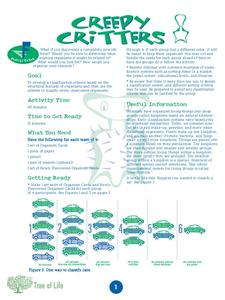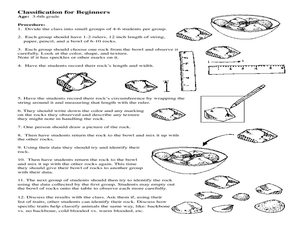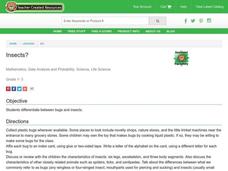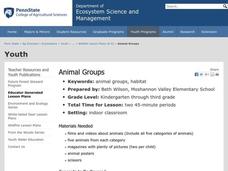Curated OER
Creepy Critters
Learners classify imaginary newly discovered organisms. In this classification lesson, students are given cards showing imaginary organisms that have been recently discovered. They must classify the organisms based on their characteristics.
Curated OER
Living and Non-Living Things | What’s Alive?
Students compare and contrast living and nonliving things. In this classification lesson plan, students read a book featuring living and nonliving things and then sort pictures of living and nonliving things.
Curated OER
Seeds and Trees Lesson Plan
Students investigate various tree leaves and use a dichotomous key to classify the leaves. In this leaf classification lesson, students study various types of leaves and their Genus. Students record observations for each Genus.
Curated OER
Classifying Dinosaurs
For this classifying dinosaurs worksheet, students follow directions to make a classification chart for each kind of dinosaur. Students follow 16 sets of directions.
Curated OER
Classifying Classes
In this classifications worksheet, students add levels of classifications for humans by splitting them into smaller and smaller classes. Students add 5 new levels.
Curated OER
Classification
Students complete an animal classification activity. In this classification lesson, students learn about the seven classification levels of animals. Students are given several animal sheets in which they separate 12 animals and run them...
Curated OER
Classification for Beginners
Students explore the process of classification. In this rock classification lesson plan, students conduct a scientific investigation that requires them to follow the provided steps to classify rocks.
Curated OER
Classification of Organisms
In this classification of organisms worksheet, students use a classification key to identify organisms, then go to a website for help in making up their own classification key.
Curated OER
Using the senses
Students use their senses to compare a frog and a hamster. In this animals comparison lesson plan, students get into groups and observe, smell, feel, and listen to what their animals are like, and classify them into categories.
Curated OER
A Planet Full of Animals
Students study animals and practice classifying them through observation activities. In this animal classification lesson, students complete a KWL chart about animals. Students then sort pictures of animals into chart categories based on...
Curated OER
What's a Mammal?
Students research his or her assigned mammal using print and online resources. In this mammals research lesson, students discover mammals have certain traits that distinguish them from animals in other classes, such as fish, reptiles,...
Curated OER
Classifying Animals
Pupils classify animals into vertebrates and invertebrates. In this animal classification lesson, students complete the online activity by dragging the animals into the correct groups. Pupils classify animals as vertebrates or...
Curated OER
In the Field with Salamanders
Students observe salamanders, take pictures of them, and classify them into an online format. In this animal classification instructional activity, students use collection materials and digital camera to photograph and observe...
Curated OER
Sorting
Students examine the concept of organization. In this library skills lesson, students practice ordering and classification skills by playing the Flood Game as well as locating and shelving books in the school library.
Curated OER
Identify, Sort, Classify
Students identify, sort, and classify. In this kindergarten math activity, students explore visual examples of sorting with 1 or more attributes. Students also practice solving problems that their instructors model.
Curated OER
Identifying and Classifying Solid Figures
Learners identify solid figures. In this classification lesson, students recognize and name solid figures. Learners identify which figures contain polygons and rectangles. Students practice counting vertices, faces and edges.
Curated OER
Insects?
Students classify animals. In this insects and bugs lesson, students discuss the characteristics of insects and other closely related animals such as spiders, ticks and centipedes. Students talk about the differences between insects and...
Curated OER
Animal Groups
Students explore animal groups. In this animal science lesson, students use pictures from magazines and classify the animals into five categories. Students share why they categorized the animals the way they did.
Curated OER
Sampling Rocks
Students examine how to take a sample by looking at rocks in the schoolyard. In this sampling lesson plan, students discuss ways to classify rocks by color, size, and weight. They think about how many rocks would make a good sample of...
Curated OER
School Yard Park/ Ecosystem
Fifth graders examine ecosystems in their schoolyard. In this nature and ecosystem lesson, 5th graders map their schoolyard into workable plots. They classify plants and animals found in the plot. They revisit their site every two weeks...
Curated OER
Sharing with Others (Private/Religious)
Learners appreciate uniqueness and differences by comparing and contrasting fruit. In this differences instructional activity, students study fruits and analyze for similarities and differences. Learners sort the fruit into five...
Curated OER
Give it Back from a Snack
Students conduct and analyze a survey about snacks. In this graphing lesson, students ascertain which snacks would be the best choice for the community. Students hold a sale and decide how the money could best be spent for the school...
Curated OER
Classification
In this classification worksheet, students examine the objects pictured in 4 sets. Students identify the picture that does not belong in each of the sets.
Curated OER
Grouping Fruits and Vegetable
Learners identify the differences between fruits and vegetables. In this nutrition lesson, students identify the properties of fruits and vegetables and group various fruits and vegetables into categories.

























